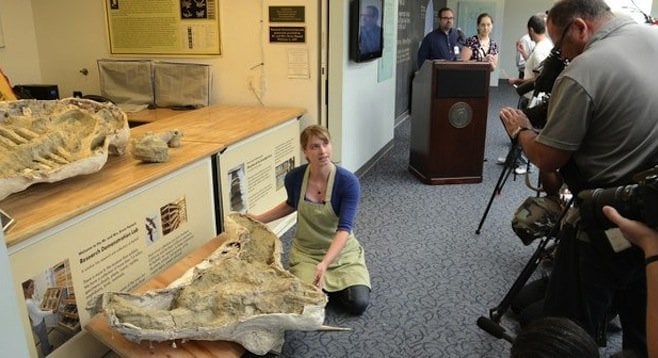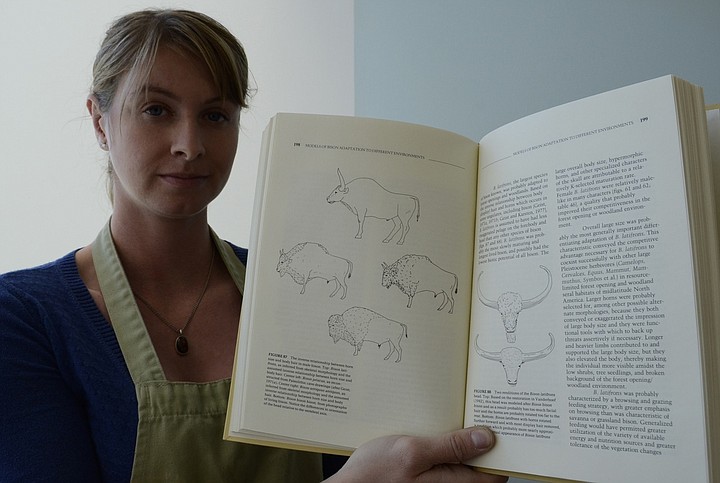 Facebook
Facebook
 X
X
 Instagram
Instagram
 TikTok
TikTok
 Youtube
Youtube

During construction of a highway ramp in San Diego’s North County last month, a paleontologist working for a local museum spotted some ancient bones in the dirt.
Brad Riney, who is described as a “paleontological monitor,” found buried treasure for the San Diego Natural History Museum during construction of a new ramp from Highway 76 onto northbound 15, near Bonsall, California.
The alert scientist gathered a crew of five persons to secure the skull and other bones of a huge, prehistoric bison. The museum “tentatively identified” the now-extinct animal as Bison latifrons. Officials said the animal roamed the San Luis Rey River Valley between 100,000 and 200,000 years ago, during an Ice Age. The animal once stood eight feet tall at the shoulder and weighed two tons, with the spread of its horns four feet across. The species became extinct about 20,000 years ago, according to museum scientists.
The discovery was made April 10, and the museum crew worked fast to move the fossils from the construction site in just two days. Two bundles of fossils were moved fifty miles south, to the downtown museum on April 12, 2013.

Nikki Anderson was on hand when the museum displayed their new treasure today, May 13, 2013. Anderson said she was one of the workers who carefully removed the bones from the construction site. “Whatever is not fossil, we call matrix,” the scientist corrected a spectator who first called the environment holding the fossil “dirt.”

Nikki Anderson and the other paleontologists first defined a perimeter around the fossils and then soaked strips of burlap in plaster, then layered plaster-strips with wooden splints to create a protected mass that could be safely moved. The bison skull was contained in one block of plaster, and another block was built around the bison pelvis and vertebrae.
Once at the museum, more delicate work is supervised by Dr. Thomas Demere. The scientists there will use small knives and brushes and handheld “pneumatic scribes” (described as “mini jackhammers”) to remove detritus from the bones.
The discovery and preservation efforts did not impact the construction schedule for the highway, according to Laurie Berman, district director for Caltrans, who was at the San Diego Natural History Museum today, May 13, 2013.


During construction of a highway ramp in San Diego’s North County last month, a paleontologist working for a local museum spotted some ancient bones in the dirt.
Brad Riney, who is described as a “paleontological monitor,” found buried treasure for the San Diego Natural History Museum during construction of a new ramp from Highway 76 onto northbound 15, near Bonsall, California.
The alert scientist gathered a crew of five persons to secure the skull and other bones of a huge, prehistoric bison. The museum “tentatively identified” the now-extinct animal as Bison latifrons. Officials said the animal roamed the San Luis Rey River Valley between 100,000 and 200,000 years ago, during an Ice Age. The animal once stood eight feet tall at the shoulder and weighed two tons, with the spread of its horns four feet across. The species became extinct about 20,000 years ago, according to museum scientists.
The discovery was made April 10, and the museum crew worked fast to move the fossils from the construction site in just two days. Two bundles of fossils were moved fifty miles south, to the downtown museum on April 12, 2013.

Nikki Anderson was on hand when the museum displayed their new treasure today, May 13, 2013. Anderson said she was one of the workers who carefully removed the bones from the construction site. “Whatever is not fossil, we call matrix,” the scientist corrected a spectator who first called the environment holding the fossil “dirt.”

Nikki Anderson and the other paleontologists first defined a perimeter around the fossils and then soaked strips of burlap in plaster, then layered plaster-strips with wooden splints to create a protected mass that could be safely moved. The bison skull was contained in one block of plaster, and another block was built around the bison pelvis and vertebrae.
Once at the museum, more delicate work is supervised by Dr. Thomas Demere. The scientists there will use small knives and brushes and handheld “pneumatic scribes” (described as “mini jackhammers”) to remove detritus from the bones.
The discovery and preservation efforts did not impact the construction schedule for the highway, according to Laurie Berman, district director for Caltrans, who was at the San Diego Natural History Museum today, May 13, 2013.
Comments